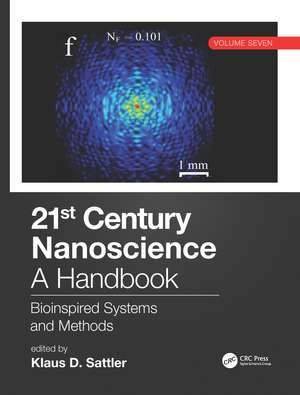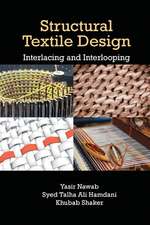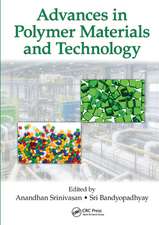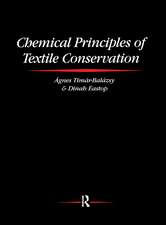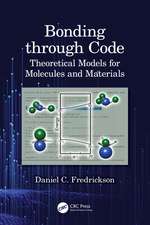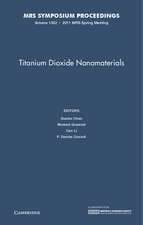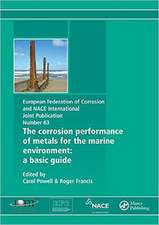21st Century Nanoscience – A Handbook: Bioinspired Systems and Methods (Volume Seven): 21st Century Nanoscience
Editat de Klaus D. Sattleren Limba Engleză Hardback – 22 apr 2020
Key Features:
- Provides the most comprehensive, up-to-date large reference work for the field.
- Chapters written by international experts in the field.
- Emphasises presentation and real results and applications.
| Toate formatele și edițiile | Preț | Express |
|---|---|---|
| Paperback (7) | 312.43 lei 6-8 săpt. | |
| CRC Press – 13 iun 2022 | 312.43 lei 6-8 săpt. | |
| CRC Press – 13 iun 2022 | 312.43 lei 6-8 săpt. | |
| CRC Press – 13 iun 2022 | 325.70 lei 6-8 săpt. | |
| CRC Press – 13 iun 2022 | 325.82 lei 6-8 săpt. | |
| CRC Press – 13 iun 2022 | 361.37 lei 6-8 săpt. | |
| CRC Press – 13 iun 2022 | 367.68 lei 6-8 săpt. | |
| CRC Press – 13 iun 2022 | 453.30 lei 6-8 săpt. | |
| Hardback (8) | 693.21 lei 6-8 săpt. | |
| CRC Press – 17 dec 2019 | 693.21 lei 6-8 săpt. | |
| CRC Press – 29 apr 2020 | 986.91 lei 6-8 săpt. | |
| CRC Press – 22 apr 2020 | 998.00 lei 6-8 săpt. | |
| CRC Press – 22 apr 2020 | 998.74 lei 6-8 săpt. | |
| CRC Press – 17 dec 2019 | 1004.20 lei 6-8 săpt. | |
| CRC Press – 11 dec 2020 | 1279.51 lei 6-8 săpt. | |
| CRC Press – 27 noi 2020 | 1302.53 lei 6-8 săpt. | |
| CRC Press – 9 noi 2020 | 1304.73 lei 6-8 săpt. |
Preț: 998.74 lei
Preț vechi: 1373.47 lei
-27% Nou
Puncte Express: 1498
Preț estimativ în valută:
191.10€ • 199.53$ • 158.17£
191.10€ • 199.53$ • 158.17£
Carte tipărită la comandă
Livrare economică 04-18 aprilie
Preluare comenzi: 021 569.72.76
Specificații
ISBN-13: 9780815357032
ISBN-10: 0815357036
Pagini: 368
Ilustrații: 178
Dimensiuni: 210 x 280 mm
Greutate: 1.11 kg
Ediția:1
Editura: CRC Press
Colecția CRC Press
Seria 21st Century Nanoscience
ISBN-10: 0815357036
Pagini: 368
Ilustrații: 178
Dimensiuni: 210 x 280 mm
Greutate: 1.11 kg
Ediția:1
Editura: CRC Press
Colecția CRC Press
Seria 21st Century Nanoscience
Public țintă
Academic and Professional Practice & DevelopmentCuprins
1. Plant-Mediated Biosynthesis of Nanoparticles - Darroudi 2. Self-Assembled Peptide Nanostuctures and their Applications - Das 3. Bacterial Detection with Magnetic Nanoparticles - Pawar 4. Nanoparticles Carrying Biological Molecules - Lenggoro 5. Silicon-Based Nanoscale Probes for Biological Cells - Tian 6. Ptychographic Imaging of Biological Samples with Soft X-Ray Radiation - Vartaniants 7. Bioapplication of Inorganic Nanomaterials - Nozaki 8. Engineered Living Materials: Designing Biological Cells as Nanomaterials Factories - Nguyen 9. Nanoparticles for Bone Tissue Engineering - Oliveira 10. DNA-Functionalized Gold Nanoparticles - Liu 11. Undoped Tetrahedral Amorphous Carbon (ta-C) Thin Films for Biosensing - Laurila 12. Charge and Spin Dynamics in DNA Nanomolecules: Modelling and Applications - Behnia 13. A Nanomaterials Genome - Qian 14. Nanoscience of Large Immunproteins -Vorup-Jensen 15. Nanozymes and their Applications in Biomedicine - Fan 16. Self-Assembling Protein Nanoparticles - Design, Production, and Characterization - He 17. Nanoengineering Neural Cells for Regenerative Medicine - Adams 18. Plasmonic Nanoparticles for Cancer Bioimaging, Diagnostics, and Therapy - Vo-Dinh 19. Nanotechnology in Cell Delivery Systems - Golchin 20. Bio-Nanoparticles: Nanoscale Probes for Nanoscale Pathogens - Draz
Notă biografică
Klaus D. Sattler pursued his undergraduate and master’s courses at the University of Karlsruhe in Germany. He received his PhD under the guidance of Professors G. Busch and H.C. Siegmann at the Swiss Federal Institute of Technology (ETH) in Zurich. He was at the University of California, Berkeley, for three years as a Heisenberg fellow, where he initiated the first studies of atomic clusters on surfaces with a scanning tunneling microscope. Dr. Sattler accepted a position as professor of physics at the University of Hawaii, Honolulu, in 1988. In 1994, his group produced the first carbon nanocones. His current work focuses on novel nanomaterials and solar photocatalysis with nanoparticles for the purification of water. He is the editor of the sister references, Carbon Nanomaterials Sourcebook (2016) and Silicon Nanomaterials Sourcebook (2017), as well as Fundamentals of Picoscience (2014). Among his many other accomplishments, Dr. Sattler was awarded the prestigious Walter Schottky Prize from the German Physical Society in 1983. At the University of Hawaii, he teaches courses in general physics, solid state physics, and quantum mechanics.
Descriere
This up-to-date reference is the most comprehensive summary of the field of nanoscience and its applications. It begins with fundamental properties at the nanoscale and then goes well beyond into the practical aspects of the design, synthesis, and use of nanomaterials in various industries.
Recenzii
"There is considerable hope for the application of nanomaterials in many fields, from nanomedicine to nanoelectronics. Editor Sattler (Univ. of Hawaii) here presents the first installment of a ten-volume series on nanoscience whose final volume (covering public policy, education, and global trends) is promised for later this year. This initial book contains 21 chapters on a variety of topics related to nanoscience, generally slanted toward theoretical concepts rather than experiment and applications (covered in later volumes). Seven chapters discuss transport theory, and another five cover numerical methods and simulations. All 21 chapters assume at least basic familiarity with their subject matter, but there is considerable variation among them in the level of experience required of readers. Chapter 12 provides a concise introduction to random matrix theory, but there is not much material on its specific applicability to nanosystems. Chapter 19 explains the use of density functional methods in nanosystems, but readers probably would need previous exposure to density functional theory. Chapter 18, on the phase behavior of nanosystems, is notably brief. Owing to the rapid pace of nanoscience research and its interdisciplinary character, this volume—and the entire series—is probably most appropriate for acquisition by institutions with active research programs in the areas of nanoscience and nanotechnology."
-M. C. Ogilvie, Washington University, CHOICE, October 2020
-M. C. Ogilvie, Washington University, CHOICE, October 2020
